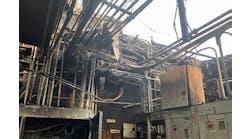ControlLogix graduates to the Ivy League
“Using current controls technology means expertise, added support and spare parts are more readily available." Thermo Systems’ Grant Selking discussed a recent chilled water system upgrade at an Ivy League university campus.
It's always admirable that process control systems can serve, often without recognition, for year after year. However, after two or three decades, there's no shame that even the most stalwart system likely needs to be reexamined, upgraded, revamped or replaced. The only justifiable regret would be not making the transition to a new control system as simple and effective as possible. Fortunately, accomplishing these migrations is getting to be far easier than it was in even the recent past.
For instance, Grant Selking, engineering manager at system integrator Thermo Systems, reported that his team recently replaced legacy Modicon controls managing the chilled water plant at an Ivy League university with ControlLogix programmable logic controllers (PLCs) and support components and software from Rockwell Automation. The application consists of four chillers with room for a fifth and 250 I/O points designed and implemented in 1998. The six-month project began in fall 2019 and was completed this past spring.
"The university had ControlLogix in other buildings on campus, so they decided to go with Rockwell Automation again," says Selking. "The existing HMI (human-machine interface) graphics package and associated licensing were leveraged, but all servers and workstations were replaced. The existing OSIsoft PI historian server was reused with new interfaces installed on the HMI servers."
Selking presented "Ivy league school upgrades legacy system to Allen-Bradley for improved reliability, optimization and scalability," this week during the Process Solutions User Group meeting this week at the Automation Fair at Home event.
Document and implement
Beyond upgrading to current PLC technology, updating and standardizing HMI graphics, and replacing HMI servers and workstations, Selking said the university also wanted to survey its network and fully document its new control system's specifications and process/alarm setpoints. This would allow new staff to train on and learn to use the control system while replacement components and software would also be easier to verify and maintain.
"Along with this retrofit, a whole new set of control panel drawings were provided with detailed wiring diagrams, so everything was also documented and labeled about what was wired where," said Selking. "We also upgraded from legacy network product to a new Rockwell Automation Stratix 5700 switch.
Selking reported the first month of the project consisted of going through the facility's existing control panels, and identifying and documenting all of its cables to develop the new control panel drawings and software specifications. "We also documented existing digital sequences and logic, so they could be replicated," added Selking. "This also let us identify pain points, so they could be fixed in the future."
The second and third months involved procurement and programming, fabricating some components, developing the PLCs and HMIs, factory acceptance testing (FAT), and performing other parts of the implementation plan. The fourth month consisted of ripping and replacing hardware, which was followed by a two-month testing and commission period. A second on-campus plant provided chilled water during the outage.
"This last stage included loop checks, functional checks and a burn-in period," added Selking. "We were going to wrap up in spring with an operations startup, but then COVID-19 put us on pause like everyone, and we had to come back a couple months later for fine tuning."
Squeezing in modern controls
Selking reported that one difficult aspect of the chiller control revamp project was that its components were all in one small area in a basement. "This was a challenge because they could only be accessed by one person at a time. One electrician had to do all the terminations and re-terminate all the cables," said Selking. "Also, because the controls were in a basement, all the components had to be broken down, carried down two flights of stairs, and rebuilt and rewired in the panel onsite.
"We also encountered some uncommented PLC programs, and many undocumented cables, which created some conflicts in the panel drawing," explained Selking. "So we just went through everything with the client, and eventually tracked everything down. One of the main benefits of this process is they gained the full panel drawings and software sequences with explanations that they wanted."
Other advantages of the new control system included its use of updated EtherNet/IP network communications protocol, as well as one ControlLogix rack and three I/O racks, with space for a fourth if needed in the future.
"Using current technology like this also means expertise is available, and so it's easier to get to the most efficient state," said Selking. "We also implemented one Studio 5000 software platform. This means added support and spare parts are more readily available, or can be shared with similar applications on campus, which reduces risk. We also put these controls into one dedicated cabinet, which also avoids the risk of unauthorized access."
The editors of Control, Control Design and Smart Industry are providing coverage of Automation Fair At Home, bringing you breaking news, innovations and insights from the virtual event. Once Automation Fair At Home is over, the editors will put together an event report featuring the top news. Pre-order your copy today.







